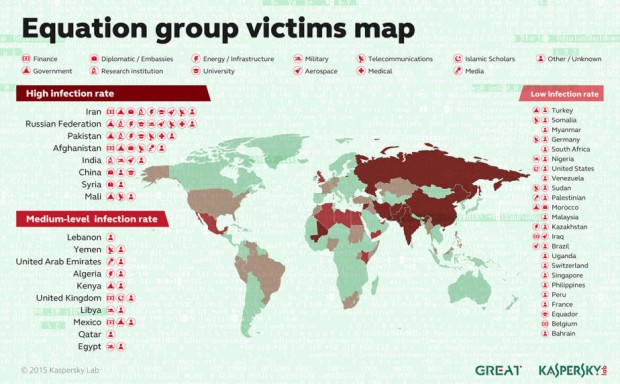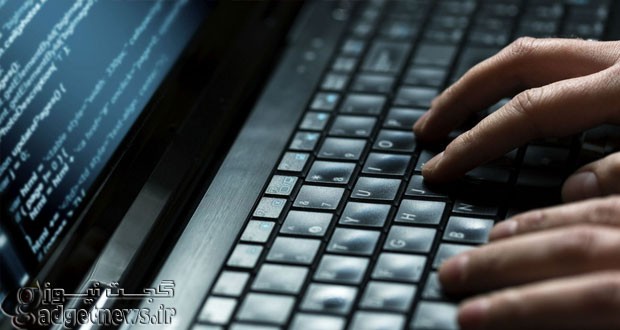بر اساس تحقیقات انجام شده توسط کمپانی امنیتی کسپرسکی، گروهی به نام اکیوئیژن از سال 2008 تاکنون جاسوسیهای گسترده ای را از طریق آلودهسازی سخت افزاری به اجرا گذاشته است.
کسپرسکی لب، کمپانی روسی فعال در حوزه آنتی ویروس و حملات سایبری دیروز فاش کرد که یک برنامه جاسوسی سطح بالا و بسیار سنگین سایبری در چند سال اخیر در جریان بوده است.
کسپرسکی گروه مسئول این عملیات را Equation Group نامیده که از طریق برنامههای جاسوسی و بدافزارهای مختلف از کامپیوترهای مراکز دولتی، اپراتورهای مخابراتی، مراکز نظامی، مراکز هسته ای، زیرساختهای انرژی و دیگر کمپانیها در بیش از 30 کشور جهان جاسوسی میکند.
کسپرسکی نام کشور حمایت کننده از اکوئیژن را اعلام نکرده، اما میگوید گروه مذکور ارتباط بسیار نزدیکی با ویروس مخرب استاکسنت دارد که توسط آمریکا و اسرائیل تولید و علیه مراکز هسته ای ایران مورد استفاده قرار گرفت. هر چند سطح عملیاتی استاکسنت در مقایسه با سطح جاسوسی این برنامه بسیار جزئیتر به نظر میرسد.
اکوئیژن از سال 1996 فعالیت خود را آغاز کرده و از سال 2008 فعالیت خود را افزایش داده است و در این راستا ابزارهای جاسوسی خارق العاده ای را تولید کرده که کسپرسکی آنها را با نامهای Equationdrug، Doublefantasy، Triplefantasy، Grayfish، Fanny و Equationlaser معرفی میکند. مجموعه این ابزارها قادر بودهاند که کامپیوترهای مجهز به ویندوز، فلش مموری های یو اس بی و حتی فرمویرها را آلوده کنند.
کسپرسکی در ابتدای گزارش خود اکوئیژن را اینگونه تعریف میکند: «این گروه حرفهترین و پیشرفتهترین گروهی است که تاکنون مشاهده کرده ایم.»
شاید جالبتوجهترین بخش این گزارش به نصب ماژولهایی به همراه ابزارهای Equationdrug و Grayfish بازگردد که اکوئیژن از آنها برای بازنویسی فرمویر هارددرایوهای تولیدی کمپانیهای مکستر، سیگیت، وسترن دیجیتال و سامسونگ استفاده میکرده است. در این روش به محض آلودهشدن هارددرایو، حتی فرمت آن و نصب دوباره سیستم عامل نیز قادر به حذف این بدافزارها نبوده است.
کسپرسکی میگوید که تأسیسات و کامپیوترهای بیش از 30 کشور دنیا شامل ایران، روسیه، سوریه، افغانستان، هنگ کنگ، مکزیک، ایالات متحده، فرانسه، سوئیس، بریتانیا و هند بالاترین سطح آلودگی به این برنامه جاسوسی را تجربه کردهاند.

گزینه جاسوسی از مراکز مالی نخستین گزینه ای است که در مورد ایران ذکر شده است.این احتمال وجود دارد که دلیل علاقه این گروه به جاسوسیهای مالی، مسأله تحریم و تأثیر آن بر اقتصاد کشورمان باشد.
از جنبههای جالب این گزارش عدم آلودگی کامپیوترهای کشورهای اردن، ترکیه و مصر بوده است.
در مجموع کسپرسکی میگوید که 500 هدف را در سراسر دنیا شناسایی کرده که مهمترین آنها کامپیوترهای از نوع سرور بوده است. در ادامه تأکید شده که این ابزارهای جاسوسی میتوانند خود را از بین ببرند، بنابراین ممکن است هدفهای غیرقابل شناسایی بسیاری وجود داشته باشد.
این گزارش کسپرسکی پس از آن منتشر میشود که چند روز پیش نیز یکی از بزرگترین دزدیهای بانکی دنیا با ارزش یک میلیارد دلار توسط این کمپانی فاش شده بود.
منبع : mashable
Massive cyber-spying program 'the Equation Group' discovered
Massive cyber-spying program 'the Equation Group' discovered
An incredibly sophisticated cyber espionage operation, likely originating in the U.S., has been discovered by the security researchers at Russia’s Kaspersky Lab.
Dubbed the Equation Group, this “threat actor” has been using spyware and malware tools to infect computers of governments, telecoms, military, nuclear research, energy and other companies in more than 30 countries. Kaspersky did not say who’s behind Equation, but its findings, presented during a security conference in Cancun, Mexico on Monday, indicate the group’s malware is closely tied to Stuxnet, a virus developed by the U.S. and Israel, used to infect Iran’s nuclear plants (it ended up infecting Russia’s plant as well).
The Equation’s level of sophistication and the scale of its operation makes Stuxnet seem like child play, according to Kaspersky’s report.
Equation has been active perhaps as early as 1996, but it boosted its operations in 2008, developing several incredibly powerful cyberweapons. Kaspersky named these tools Equationdrug, Doublefantasy, Triplefantasy, Grayfish, Fanny and Equationlaser. Together, this malware suite was able to infect Windows computers, USB sticks and even hard drive firmware, letting Equation steal data from targeted computers and stay undetected for years.
Perhaps the most interesting tools mentioned in the report are modules that are used together with the Equationdrug and Grayfish malware platforms, enabling Equation to reprogram the firmware of hard drives built by all major manufacturers, including Maxtor, Seagate, Western Digital and Samsung.
Once a hard drive was infected, even formatting it and reinstalling an OS would not be sufficient to get rid of the malware.
Once a hard drive was infected, even formatting it and reinstalling an OS would not be sufficient to get rid of the malware.
Kaspersky observed victims of the Equation group in more than 30 countries, including Iran, Russia, Syria, Afghanistan, Hong Kong, Mexico, United States, France, Switzerland, United Kingdom and India. Interestingly, there are indications that Equation specifically avoided infecting computers in Jordan, Turkey and Egypt.
All in all, Kaspersky counted more than 500 infections globally, many on important, server-type machines. However, infections have a self-destruct mechanism, meaning there may have been many more, which are now undetectable.
Kaspersky’s report offers more details about Equation’s actions, targets and the tools the group used. The most important takeaway is that there’s an organization out there (and it’s probably not alone) with immense knowledge and resources that can precisely and invisibly target and steal data from nearly any computer — even the best guarded, including those belonging to government or military.
Kaspersky’s findings have been announced after the company publicized its discovery one of the largest banking cyber-heists ever, with hackers stealing as much as $1 billion from banks all over the world.
Update: While Kaspersky’s report is pretty thorough when it comes to technical details, the clues about the origins of the Equation group are inconclusive. We reached to Kaspersky for comment, and this is the response we got:
“Kaspersky Lab experts worked on the technical analysis of the group’s malware, and we don’t have hard proof to attribute the Equation Group or speak of its origin. With threat actor groups as skilled as the Equation team, mistakes are rare, and making attribution is extremely difficult. However we do see a close connection between the Equation, Stuxnet and Flame groups.”
 گجت نیوز آخرین اخبار تکنولوژی، علم و خودرو
گجت نیوز آخرین اخبار تکنولوژی، علم و خودرو 






